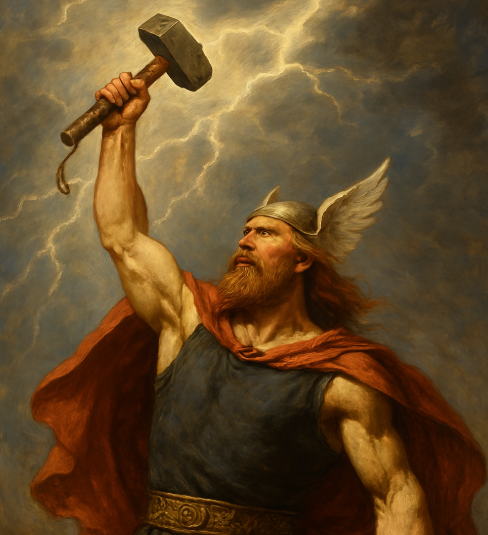
Who can lift Mjolnir?
Share
Who Can Lift Mjolnir? Myth vs. Marvel
Who can lift Mjolnir? It’s one of the most debated questions among fans of Norse mythology and modern pop culture alike. While Marvel’s version of Thor’s hammer can only be lifted by the “worthy,” the original Norse myths tell a different story. As researchers, historical replica makers, and lovers of Viking lore, we’ve dug into the Poetic Edda, Prose Edda, and sagas to uncover the truth. Spoiler: Thor isn’t the only one who’s lifted Mjolnir — and it has nothing to do with being morally upright.
Surprised? Most people are!
Mjolnir in Norse Mythology: Not Just for Thor?
In the original Old Norse sources like the Prose Edda and Poetic Edda, Mjolnir is certainly a legendary weapon belonging to Thor, the god of thunder. It’s described as incredibly powerful, capable of leveling mountains and summoning lightning, and yes, it's very heavy. But there's no mention of enchantments about who is “worthy” to lift it.
Instead, the difficulty lies in its sheer weight and unusual design. In the Prose Edda, Skaldskaparmal from the 13th century, the handle was made too short because Loki tampered with the dwarves during its forging. That made Mjolnir hard to handle, but not magically exclusive to Thor.

So Where Did the “Worthiness” Idea Come From?
The whole “only the worthy can lift Mjolnir” rule? That’s pure Marvel Comics.
In Marvel's universe, Odin places an enchantment on the hammer so that only those deemed morally worthy can lift it. This leads to iconic moments where Captain America, Vision, and even Jane Foster(as Thor) are able to wield Mjolnir. It's a cool concept — and it’s now a central theme in the Marvel Cinematic Universe, but it has no historical basis in the original myths.

So… Who Else Has Lifted Mjolnir?
Believe it or not, Thor isn’t the only character in Norse mythology to hold Mjolnir. That’s right. While Thor is the only one who regularly uses the hammer in the myths, there are others who held it on numerous accounts. A few surprising figures have managed to get their hands on the god of thunder’s famous hammer, even if they didn’t necessarily wield it with divine thunderbolts.
First of all, it’s important to mention that Thor needs special gear to handle Mjolnir. According to Snorri Sturluson’s Gylfaginning in the Prose Edda, Thor relies on iron gloves, called Járngreipr, to grip the hammer properly. Without them, even Thor himself couldn’t control it — which says a lot about its raw power and danger.
Giants Held It Too?!
Yes, really. One of the most well-known myths — Þrymskviða, or “The Lay of Thrym” — tells us about the giant Thrym, who steals Mjolnir and demands the goddess Freyja as his bride in exchange for its return. In this story, Thor has to disguise himself as Freyja and crash the wedding feast to retrieve it. When the hammer is finally placed in “Freyja’s” lap, Thor breaks disguise, grabs it, and unleashes havoc on the giants.

So, if you’ve ever wondered who can hold Mjolnir, the answer — according to the myths — includes giants, too. They could steal it. But could they wield it with divine thunder powers? That’s still up for debate.
Thor’s Sons: Magni and Modi
Thor’s two sons, Magni and Modi, are said to inherit Mjolnir after Ragnarök — the prophesied end of the Norse world. While it’s unclear in the sources whether they each possess the same strength as their father, it’s suggested that together, they are capable of lifting and using the hammer. This ties into the idea that Mjolnir’s power can be passed down, though probably not as easily handled as by Thor himself.

Final Thoughts: Is Mjolnir Only for the Worthy?
So, who can lift Mjolnir? In Norse mythology, it’s not about being “worthy” — it’s about being strong enough, prepared, and sometimes just lucky (or sneaky) enough to grab it. Thor, his sons, and even giants have all held it at some point. Marvel may have added enchantments and moral rules, but in the old Viking stories, power wasn’t always so black-and-white.
If you love Thor’s hammer, check out our [Mjolnir pendant collection] — featuring authentic replicas inspired by actual Viking-age finds.
